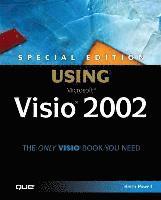
Fler böcker inom
- Format
- Häftad (Paperback)
- Språk
- Engelska
- Antal sidor
- 576
- Utgivningsdatum
- 2002-10-01
- Upplaga
- 1
- Förlag
- QUE
- Medarbetare
- Adolphson, David W.
- Illustrationer
- illustrations
- Dimensioner
- 234 x 190 x 33 mm
- Vikt
- Antal komponenter
- 1
- ISBN
- 9780789726841
- 930 g
Special Edition Using Microsoft Visio 2002
Häftad,
Engelska, 2002-10-01
391
Tillfälligt slut – klicka "Bevaka" för att få ett mejl så fort boken går att köpa igen.
Kundrecensioner
Har du läst boken?
Sätt ditt betyg »
Övrig information
Keith A. Powell has many years of technology industry experience as well as authoring several books on the various software tools and operating system products that have been popular since the 1980s. He is a senior manager with KPMG Consulting in Chicago, and devotes the majority of his time working with the latest techniques surrounding the topics of e-Commerce architecture, strategy, security, and deployment. He and his long-time best friend and wife, Vannessa, spend much of their free time enjoying rollerblading and bike riding in the lakefront parks of Chicago. Keith can be reached with questions/comments anytime at ChicagoBooks@msn.com or kpowell@kpmg.com.
Innehållsförteckning
Introduction.
I. VISIO BASICS.
1. A Review of Visio 2002 Tools and Commands.What's New in Visio 2002? Exploring the Visio 2002 Interface. Understanding Stencils. Using Shapes to Create Basic Drawings. Understanding the Drawing Page. Drawing Tools. The Size & Position Window. Efficiency Shortcuts.2. Inserting Objects Using Object Linking and Embedding.
Understanding Object Linking and Embedding. Why Link or Embed? Differences Between Linking and Embedding to Visio. Considerations for When to Use Linking Versus Embedding. Inserting a New Object Using OLE Embedding. Inserting an Existing Object.3. Understanding and Using Pages and Layers.
Why Use Pages and Layers? Pages and Layers Defined. Inheritance and Inserted Pages. Understanding the Special Details. Creating and Editing Layers. Printing.4. Making Drawings Interactive with Hyperlinks.
What Is a Hyperlink?. Relative Versus Absolute Hyperlinks. On-Page and Off-Page Reference Shapes. Creating a Hyperlink. Following a Link.5. Creating Custom Toolbars and Menus.
The Customize Window. Using the Visio 2002 Toolbars. Creating a Custom Toolbar. Customizing and Creating Menus. Understanding Name and Accelerator Characters (Hotkeys).6. Defining a Style in Visio 2002.
Components of a Visio Style. Steps to Defining a New Style. A Few More Style Hints.7. Finding the Right Shape Using Find Shape.
What Is Find Shape? Using Find Shape. Searching for Files in Visio 2002.8. Using Operations on the Shape Menu.
Review of Drawing Tools. Characteristics of Open and Closed Shapes. Shape Operations.9. Modifying Shape Behavior.
Establishing Settings for Shape Behaviors Using the Behavior Tab. Establishing Settings for Selection Operations Using the Double-Click Tab. Establishing Settings for Interactions Between Shapes and Dynamic Connectors Using the Placement Tab.10. Using Files and Setting Custom Properties.
Understanding ShapeSheet Basics. Understanding Custom Properties. Adding Data to Existing Custom Properties. Defining New Custom Properties. Obtaining Reports Based on Custom Properties.11. Editing and Creating Stencils.
Editing an Existing Stencil. Creating New Masters. Working with Masters. Creating a New Stencil. Documenting a Stencil.12. Creating a Custom Template.
What Templates Are and How They Work. Template Components. When to Create a Template. Creating and Saving a Custom Template.
II. USING THE VISIO WIZARDS AND KITS.
13. Creating and Maintaining Charts Using Macros.Creating Flowcharts Using the Import Flowchart Data Wizard. Creating Organiza...
Du kanske gillar
-
Nexus
Yuval Noah Harari
Häftad -
Careless People
Sarah Wynn-Williams
Inbunden -
Doppelganger
Naomi Klein
Häftad
